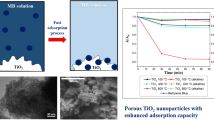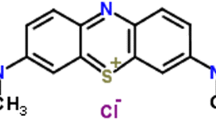Abstract
Decolorization of dye solutions, crystal violet and congo red, were investigated using the synthesized amorphous titanium dioxide and compared with commercial titanium dioxides: Degussa P25 and anatase. Results showed that amorphous TiO2 had good adsorptivity that could decolorize the dye polluted water effectively mainly by adsorption. Decolorization by photocatalytic property was also detected but was very low. Concentrations of dye solutions used in this work were about ten times higher than normally used in other reports. After use, the particle surface was completely covered with dye molecules but this could be regenerated and the cleaned particles could be reused several times. Hydrogen peroxide and ultraviolet irradiation were used in the regeneration process.








Similar content being viewed by others
References
Zainal Z, Hui LK, Hussein MZ, Taufiq-Yap YH, Abdullah AH, Ramli I (2005) J Hazard Mater 125:113
Salem IA (2000) Appl Catal B 28:153 and references cited therein
Sauer T, Cesconeto Neto G, José HJ, Moreira RFPM (2002) J Photochem Photobiol A 149:147
Senthilkumaar S, Kalaamani P, Subburaam CV (2006) J Hazard Mater B 136:800
Purkait MK, Maiti A, DasGupta S, De S (2007) J Hazard Mater 145:287
Namasivayam C, Kavitha D (2002) Dyes Pigm 54:47
Wang L, Wang A (2008) J Hazard Mater 160:173
Singh V, Sharma AK, Tripathi DN, Sanghi R (2009) J Hazard Mater 161:955
Khataee AR, Vatanpour V, Amani Ghadim AR (2009) J Hazard Mater 161:1225
Namasivayam C, Kanchana N (1992) Chemosphere 25:1691
Deo N, Ali M (1993) Indian J Environ Prot 13:496
Namasivayam C, Arasi DJSE (1997) Chemosphere 34:401
Dutta PK (1994) Indian J Environ Prot 14:443
Namasivayam C, Yamuna RTJ (1992) Chem Technol Biotechnol 53:153
Hoffman MR, Martin ST, Choi W, Bahnemann DW (1995) Chem Rev 95:69
Stylidi M, Kondarides DI, Verykios XE (2004) Appl Catal B 47:189
Ding XZ, Liu XH (1997) Mater Sci Eng A 224:210
Bakardjieva S, Šubrt J, Štengl V, Dianez MI, Sayagues MJ (2005) Appl Catal B 58:193
Randorn C, Wongnawa S, Boonsin P (2004) ScienceAsia 30:149
Kanna M, Wongnawa S, Sherdshoopongse P, Boonsin P (2005) Songklanakarin J Sci Technol 27:1017
Tanaka K, Campule MFV, Hisanaga T (1991) Chem Phys Lett 187:73
Ohtani B, Ogawa Y, Nishimoto S (1997) J Phys Chem B 101:3746
Jensen H, Joensen KD, Jorgensen J-E, Pedersen JS, Sogaard EG (2005) J Nanopart Res 6:519
Zhang Z, Maggard PA (2007) J Photochem Photobiol A 186:8
Baiju KV, Shukla S, Sandhya KS, James J, Warrier KGK (2007) J Phys Chem C 111:7612
Clark RJH (1968) The chemistry of titanium and vanadium. Elsevier Publishing Co., Amsterdam
Houas A, Lachheb H, Ksibi M, Elaloui E, Guillard C, Herrmann J-M (2001) Appl Catal B 31:145
Galindo C, Jacques P, Kalt A (2000) J Photochem Photobiol A 130:35
Shu H-Y, Chang M-C (2005) J Hazard Mater 125:96
Shu H-Y, Chang M-C (2005) J Hazard Mater 125:244
Rosenfeldt EJ, Linden KG, Canonica S, von Gunten U (2006) Water Res 40:3695
Huang C-P, Huang Y-H (2009) Appl Catal A 357:135
Moura FCC, Oliveira GC, Araujo MH, Ardisson JD, Macedo WAA, Lago RM (2006) Appl Catal A 307:195
Han Y-F, Chen F, Ramesh K, Zhong Z, Widjaja E, Chen L (2007) Appl Catal B 76:227
Acknowledgments
This research is supported by the Thailand Research Fund through the Royal Golden Jubilee Ph.D. Program (Grant No.PHD/0126/2546 to M.K.); the Center for Innovation in Chemistry (PERCH-CIC), Commision on Higher Education, Ministry of Education; and the Graduate School of Prince of Songkla University (to both M.K. and S.B.). Sample of Degussa P25 used throughout this work was donated by Degussa AG, Frankfurt, Germany, through its agency in Bangkok, Thailand.
Author information
Authors and Affiliations
Corresponding author
Rights and permissions
About this article
Cite this article
Kanna, M., Wongnawa, S., Buddee, S. et al. Amorphous titanium dioxide: a recyclable dye remover for water treatment. J Sol-Gel Sci Technol 53, 162–170 (2010). https://doi.org/10.1007/s10971-009-2072-5
Received:
Accepted:
Published:
Issue Date:
DOI: https://doi.org/10.1007/s10971-009-2072-5




